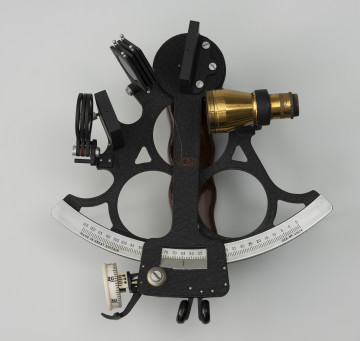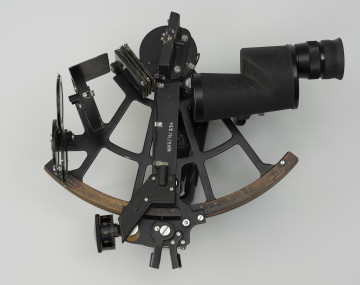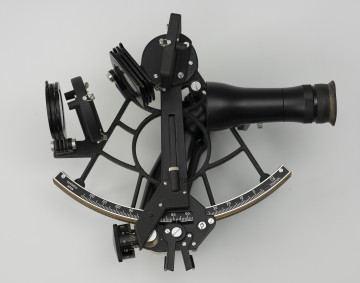
Kelvin&Hughes sextant
1951 — 1975
National Museum in Szczecin
Part of the collection: Navigation history
The invention of both the octant and the sextant is most often attributed to the English mathematician John Hadley (1682-1744), but at the same time, the glassblower and self-taught astronomer Thomas Godfrey (1704-1749) of Philadelphia was working on a very similar invention. Both instruments were modelled on the design of Isaac Newton (1642-1727), which he had proposed decades earlier but published after his death, and are used to measure the height of celestial bodies above the horizon, as well as the horizontal and vertical angles between objects. The main difference between the two lies in the size of the limbus, a rounded base with an angular scale, which in the case of the sextant is a 1/6th slice of a circle and in the case of the octant is a 1/8th slice. The use of mirrors reduced the risk of measurement errors, which to a small degree lied on the observer recording, via the octant, the position of the star and horizon simultaneously. This was of great importance at sea when the ship was constantly rocked by waves. To top it off, the instrument could be used both during the day and at night. The usefulness of the octant and sextant meant that, by about 1780, they had superseded most of the previously used measuring instruments. In 1767, detailed tables were published providing calculations for the "lunar distance", from which a sailor measuring celestial bodies could determine Greenwich time and thus calculate the longitude at which they were located. Although the method itself had been known since the 16th century, the complicated and lengthy calculations meant that it was not used at sea. To measure lunar distance, but the octant had a small scale in measuring lunar distance, but the octant had a scale too small for this purpose on the limbus, so it gradually fell out of use in the second half of the 18th century. The featured piece was produced by a German company founded in Hamburg in 1816 by a Scotsman, William Campbell, dealing in optical and, for a period, nautical products. Campbell is still in business today, supplying the German and American markets with high-quality eyewear. Leszek Kocela
Author / creator
Object type
octant (instrument)
Technique
batch production
Material
brass, ebony, bone
Origin / acquisition method
purchase
Creation time / dating
Creation / finding place
Owner
Muzeum Narodowe Szczecin
Identification number
Location / status

1951 — 1975
National Museum in Szczecin

1960 — 1970
National Museum in Szczecin

1983-02-28
National Museum in Szczecin
DISCOVER this TOPIC
National Museum in Szczecin
DISCOVER this PATH
Educational path